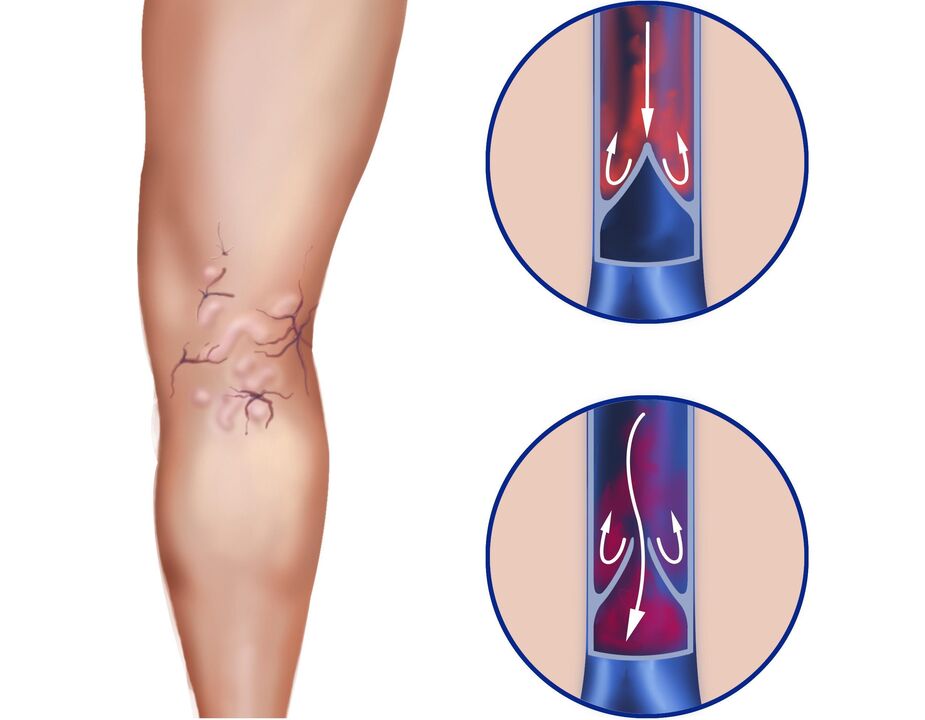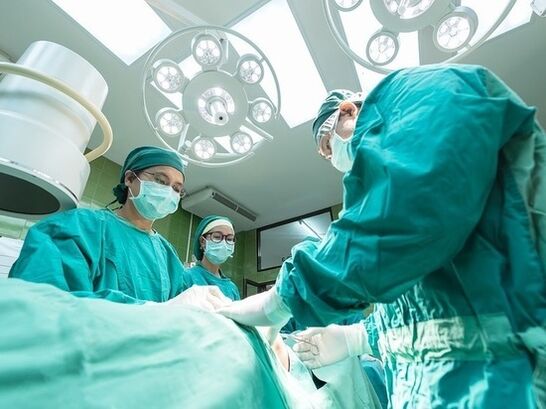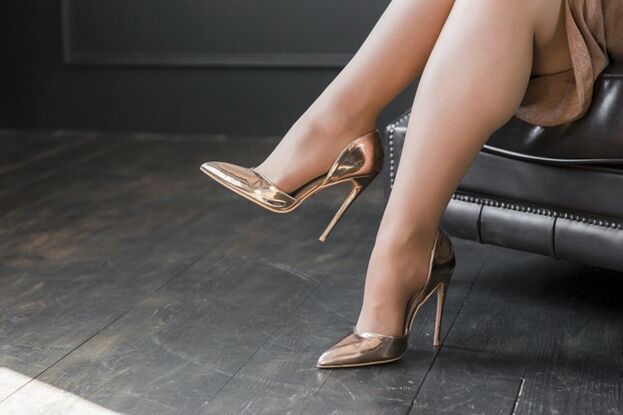Varicose veins of the lower extremities or varicose veins of the lower extremities - spread of surface veins, accompanied by valve failure and the injured blood flow.
This is the most common disease of peripheral vessels.According to epidemiological data, different forms of this disease are located in 26-28% of women and 10-20% of working age men.
Risk factors for varicose vein development
Heredity and his role in varicose vein development are not unequivocal certificates.One of the main contraargumments of the presence of genetic predisposition is different frequencies of varicose disease in ethnic Africans and their colleagues who emigrated into the United States and Western Europe countries.Moreover, compared to the Sedentar Colleagues, the tribes, frequency of varicose veins, which does not exceed 0.5%, emigrants have a reliable increase in frequency of 10-20%.In this regard, the conclusion is obvious regarding the varicose of environmental factors, the characteristics of the lifestyle and nutrition.
PregnancyIt is traditionally considered one of the main risk factors for varicose veins development, especially more often (3-4 times) damage to women.It is generally accepted that the main causing moments increase of the BCC (circular volume) and the compression of the pregnant cervix of retroperitoneal veins.Meanwhile, the results of epidemiological studies show that only the second and subsequent pregnancy leads to a reliable increase in varicose veins frequency by 20-30%.At the same time, the first signs of the disease appear already in 1. the trimester of pregnancy, when a sharply increase in the BCC or the increase of the pregnant woman is not yet.
Obesity- Proven risk factor for varicose veins.At the same time, increasing the body weight index to 27 kg / m2 and more leads to an increase in the frequency of diseases by 33%.
The high frequency of varicose veins in industrialized countries is due to the food characteristics.The high degree of food processing and reduction in crude vegetables and fruit has led to a permanent lack of plant fibers needed to rearrange the venous wall and chronic prison, which cause a permanent increase in intra -abrod.
LifeIt has a significant impact on the development and flow of varicose veins.The negative effect of long-term static loads with raising or motionless stays in a permanent and sitting position is especially proven.In Asian countries, the use of chairs and chairs in the European part of the population led to a reliable (3-4 times) increases the frequency of varicose veins in relation to people who traditionally sit in rugs.
Special conditionsParticipate in the pathogenesis of varicose veins.Their role in recent years is gradually increasing, which is due to the wide use of hormonal contraception, popularization of hormonal replacement therapy in the period in the treatment of osteoporosis.It has been proven that estrogen and progesterone, as well as their derivatives, reduce the tone of the venous wall due to gradual destruction of collagen and elastic fibers.
Clinical picture of varicose veins
Varicose veins is a disease that is not indifferent to beautiful sex.Varicose veins of female veins are ill on average three times more often than men.

The signs of varicose veins are covered by the expansion of subcutaneous veins, pain, severity in legs, swelling of the foot and lower leg, fatigue in the legs by the end of the day.Varicose nodes are often prone to form blood clots and infections.Felbis can develop - inflammation of blood vessels or thromboflebitis - inflammation of blood vessels complicated with blood clots.In the course of the veins, they are claimed, very painful cables.The skin changes, loses elasticity and color - becomes thick, dark brown.Sores appear with a simple injury.A young woman can become a person with a disability between the ages of 40.
These are symptoms should be warned - these are the symptoms of varicose veins:
- Pain.The causes of pain in varicose veins are very, very numerous.A variety of pain in varicose veins is also very rich:
- Hot pulsating pain,
- Night cramps and itching in muscles,
- Pain when walking
- Pain along the vein troops,
- General pain and leg pain.
- Swelling in your legs.
- A feeling of cracking and weight in your legs.
- Skin changes.At first, the skin becomes dry, pigmentation appears - the skin of the legs darkened, covered with brown "tacts".Later, various dermatitis, eczema and thus - the corded trophic disorders in the form of weak wounds of the wound to the formation of ulcers can join these symptoms.
- Bent, elongated varicose veins protruding above the surface of the legs and feet, cylindrical or mixed extensions.
- Vascular stars (telangioetassium).Yes, people with varicose veins are also involved in a group of patients with the spread of small veins, because the causes of their appearance are the same.
The earliest phases of varicose veins development is very difficult to detect and diagnose, because in very early stages of the disease there is no main characteristics - varicose veins.And the first and earliest symptoms of varicose veins, like a sense of leg severity, moderate leg pain, increased fatigue, are also found in the initial phases of arterial diseases, straight feet, lumbar osteochondrose.
In such difficult cases, it is impossible to make the exact diagnosis itself - you will need a consultation of doctors or even a few experts - fleet, neurologists, surgeons and manual therapists.It will also be necessary and highly prophetic instrumental diagnostic methods, such as ultrasound or phlebography, will also be needed.
The first symptoms of varicose veins, with whom you yourself cannot be suspected at the beginning of varicose veins, increasing is a sample of veins on the skin of the leg.This defect, as we have already noticed, which most often notices young women: the wrangles noticed on their feet or hips, which have not been there before.There are no other complaints at the beginning of varicose veins.
And often, such symptoms of starting varicose disease precede the appearance of pain and other unpleasant sensations.Often the first "findings" of the vein do not follow absolutely without unpleasant sensations.
The beginning of the development and advancement of varicose veins is already manifested by protrusion above the surface of the skinVaricose nodes.One or more.This is the main symptom of the beginning of a varicose disease.Varicose nodes can be most commonly detected on the inner surface of the legs or hips.With long walking or extended standing, such a symptom of varicose veins is manifested asFatigue, weight in legs, feeling of cracking(often - in calves).These symptoms are especially clearly read with a long stay in a sitting or standing position.There is also pain or acute pain in varicose veins (extended veins), convulsions in veal muscles, especially in the evening, and sometimes at night.
The first signs of dysfunction in the veins are manifested andswelling of the leg by the end of the day.Edem usually occurs in the evening, especially after an extended standing.After the night rest, swelling completely disappears.
These symptoms of varicose expansion expansion initially transitions quickly, if you relax, especially if you lie down.However, a disappearance or significant reduction in these symptoms for walks and after the night rest are very characteristic of the symptoms of varicose disease.
But varicose veins, if they are seriously not engaged, do not withdraw,advancement.Time, such symptoms of varicose veins asWon with dark blue intradermal veins, protruding above the surface of the skin of the legs and feet and the like the clusters of red grapes.All this is accompaniedShooting with pain in legs and calves, feeling warming in legs, night convulsions in veal muscles, swelling.Gradually join these symptomsSkin changes.At first the skin becomes dry, they darken, the pigment appears on it - brown spots.Something later soTrophic disorders: Bad healing wounds explosions and even ulcers.
PainThey start bothering more often, especially in the afternoon or in the evening.
Diagnostics
Currently, the main affordable methods for diagnosing varicose veins:
- Ultrasonic Dopplerography.The most common method of primary diagnosis of diseases of the lower extremities is today is ultrasound dopplerography.This method is based on the effect of Doppler, which consists in the fact that ultrasound waves go through fabrics reflect from the transfer of blood cells and change their frequency.Highly sensitive sensors, fixing these changes, playing them with a separate device in the form of sound signals that resemble a wind noise or graphic curve.
- Duplex (two -dimensional) scan allows you to capture a venous vessel image on the monitor screen in real time with the blood flow assessment in it.Triplex (three -dimensional) scanning, next to the above, allows you to get a picture of the blood flow color.
- Flebography.Flebography is a radiope study of the vein, which was, and in some cases the diagnostic method of testing patients with veins and, mainly in the case of their complications.
Treatment of varicose veins

The successful solution to the problem of varicose veins treatment consists of sequential application of the following tasks:
- Elimination of varicose veins;
- Elimination of HVN signs;
- Prevention of progress and relapse diseases.
Ways to treat varicose veins:
- Compression therapy;
- Conservative therapy;
- Surgical treatment (flebectomy);
- Sclerotherapy.
First of all, they try to treat varicose veins with conservative methods.Strictly, this is not a method of treatment of varicose veins.All conservative methods in the "treatment of varicose veins" are intended primarily for you, on the prevention of diseases and its complications.Conservative methods are also the only possible therapy if the patient has serious contraindications on other treatment methods or if the patient refuses the surgical treatment of varicose veins.Radical removal of varicose syndrome is possible surgical only, simultaneously, the functional result of treatment is of great importance, which means removing or minimizing HVN manifestations.

The treatment of varicose veins should be complex and an individual, most often, including conservative and surgical treatment.The doctor can only recommend the method of treatment of varicose veins based on his experience, but the decision always remains























